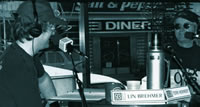The Story of Henry Schueler

Listen to Cubs broadcasters Pat Hughes and Ron Santo on air commentating about the Foundation at Wrigley Field!
Henry’s football number at St. Mary of the Woods and St. Patrick High School was 41. His baseball number, while a member of ESAA baseball and ESAA All-Star teams, the Edgebrook Bulldogs and St. Patrick’s was 9. Those numbers were special to Hank and his family and figured prominently throughout his illness.
Hank was diagnosed with a rare subtype (hypodiploidy) of acute lymphoblastic leukemia or “ALL” in November of 2006. Because of the generally poor prognosis of his disease subtype, it was recommended that he undergo a bone marrow transplant following a four month block of intense chemotherapy at Children’s Memorial Hospital in Chicago.
On March 9, 2007, his 14th birthday, he began his pre-transplant therapy at Children’s Hospital of Wisconsin. On March 16, 2007, he received his new marrow from a 27 year old man from Germany. Forty-one (41) days later he enjoyed his first full day out of the hospital. He returned to school to graduate with his 8th grade class in June of 2007, and returned to the baseball diamond on June 7, 2007, well ahead of schedule.
According to his transplant team, Hank recovered quicker than any other patient they had ever treated. Anyone who knew Hank well was not surprised. He went on to enjoy a full productive summer with family and friends prior to beginning high school at St. Patrick High School in Chicago in August, 2007.
Unfortunately, in early September, his leukemia unexpectedly relapsed. He once again had to begin chemotherapy treatments to put his leukemia in remission, this time at Children’s Hospital of Wisconsin. At the conclusion of his initial re-induction program, at the end of September, he developed a fungal infection, a risk not uncommon to immuno compromised patients like Henry. He fought valiantly over the next two and a half months against both the invasive mucor fungal infection and the underlying leukemia and received another bone marrow transfusion from the same anonymous German donor the day after Thanksgiving. Sadly in mid-December the infection progressed to his brain causing a massive intracranial bleed, resulting in his untimely death on December 14, 2007.
Henry did not want to die. He made that abundantly clear to us. Yet he also displayed an uncommon maturity and courageous countenance in the face of overwhelming medical odds. He simply refused to quit. For anyone who witnessed his grit and determination on a playing field, it again would not come as a surprise. He was both a Knight and a Bulldog on and off the field, and had the heart of a Shamrock in him.
